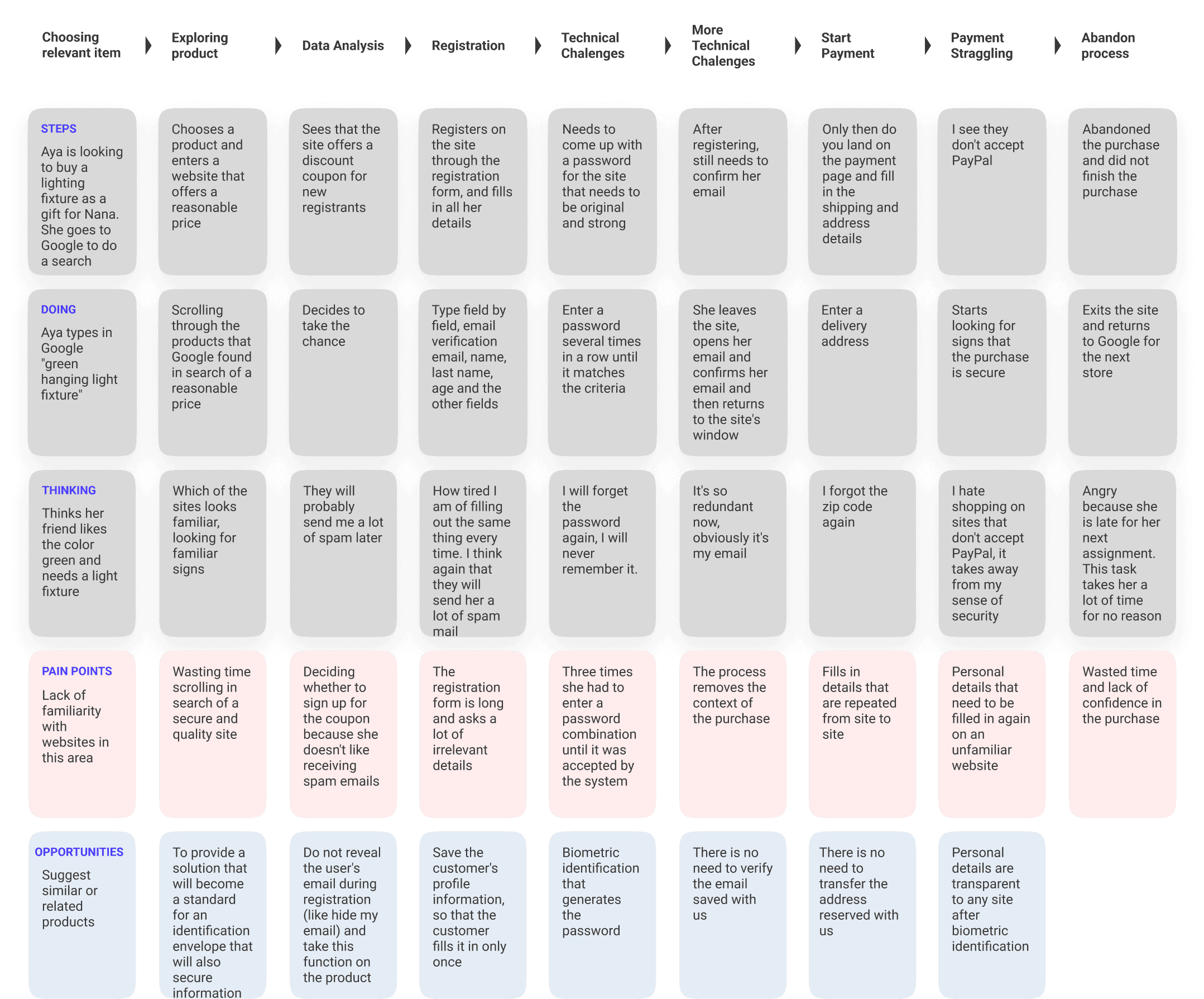Biometric Authentication Research - effortless security with biometric logins
Seamless Security: Elevating Trust and Convenience in E-Commerce with Biometrics
Our identity product enhances websites by integrating biometric authentication methods like Face ID and fingerprint into existing login and registration flows. This streamlines the user experience, making authentication easier, more convenient, and more secure than traditional password-based methods.
Tool:
Zoom, Google Forms
Type:
UX Research
12
Weeks
5
Moderated Interviews
30
Surveys
2
Researchers
About
This research explores how biometric authentication (face ID, touch ID, & Fingerprint) improves the signup experience in online shopping. Registration is often seen as a hassle, leading to drop-offs. Addressing their pain points can enhance the shopping experience and streamline online purchases.
Key themes and conclusions
Lengthy and repetitive registration forms create friction, causing user drop-off.
Biometric authentication is perceived as both secure and user-friendly, reducing barriers to entry.
Fear of spam emails discourages users from registering.
Key recommendations
Build an authentication solution that seamlessly integrates with any website, much like how Stripe and PayPal simplify payments.
Enhance user trust and reduce friction by adopting familiar authentication methods like Face ID, fingerprint, or PIN.
It is recommended to research the possibility of external system that performs load balancing of the ads sent to the customers.
Research objective
Examine how biometric authentication impacts website registration, aiming to increase user signups and boost conversion rates.
Hypotheses to validate
Positioning the website as more secure through biometric authentication is anticipated to positively influence users' decisions to log in or register on the site.
Simplifying and streamlining the authentication process is expected to increase user conversion rates by 20%.
Tools used

Methodologies and Execution
Research Methods and Rationale
This study combined qualitative and quantitative approaches, including stakeholder interviews, surveys, and literature reviews, to provide a comprehensive understanding of biometric authentication’s impact on user behavior.
Interviews with Organizational Stakeholders
The purpose of these interviews was to gather insights and foundational assumptions from key stakeholders within and outside the organization.
ROOLY ELIEZEROV
Founder, OwnID
Purpose
Explore the impact and challenges of implementing biometric authentication in e-commerce.
Key Insights
Yossi discussed the growing demand for seamless user experiences, noting biometric authentication as a solution to security and convenience pain points. He also highlighted compatibility challenges but stressed the competitive advantage of overcoming these hurdles.
YOSSI RABINOVICH
Founder, Retalix
Purpose
To gain insights into the potential impact and challenges of implementing biometric authentication in e-commerce from an industry veteran.
Key Insights
Yossi shared his perspective on the evolving landscape of e-commerce and the increasing demand for seamless user experiences. He noted that biometric authentication could be a game-changer by addressing common pain points related to security and user convenience. Yossi also highlighted potential challenges, such as ensuring compatibility across various devices and platforms, but believed that overcoming these hurdles would provide a significant competitive advantage in the market.
Internal Literature
We reviewed internal product documents outlining key flows and strategies, providing insights into current authentication processes and the strategic vision for integrating biometric authentication.
External Literature
We analyzed resources from Growth.Design, focusing on the psychology of signups. These materials offered insights into user behavior, motivations, and barriers, crucial for creating effective authentication experiences.
Process

Competitor Research
Domain Research
We conducted a competitive analysis to understand how companies implement biometric authentication. This research highlights best practices, potential pitfalls, and opportunities to differentiate our approach.
AUTH0
Highlights that identity management encompasses much more than just the login box, stressing the broader implications and importance of comprehensive identity solutions.
STRIPE
A good example of an external payment framework that simplifies transactions for websites.
1PASSWORD
Transitioned from password management to passwordless authentication, showcasing the evolution towards more secure and user-friendly authentication methods.
FRONTEGG
Emphasizes security in its messaging, reinforcing the importance of secure authentication methods.
CORBADO
Utilizes the concept of passkeys, which, although not widely known among users, represents a modern approach to authentication.
Qualitative research
INTERVIEWEE CRITERIA


MAIN MOTIVATIONS TO SIGN UP

Routine and Convenience: Users sign in when shopping becomes a regular part of their routine, making decision-making easier and encouraging frequent logins.
Faster Checkouts: Users value faster checkout experiences, which enhance the overall shopping experience.
Trust and Familiarity: Trusted brands provide a sense of safety, especially when familiar, which encourages repeat visits.
Financial Incentives: Financial incentives, such as discounts and offers, add perceived value to the registration process.
Personalization and Social Proof: Personalized recommendations and social proof encourage users to sign up by enhancing their trust and perceived benefit.
Exclusive Member Benefits: Access to exclusive member benefits, like early sales or special products, makes registration feel worthwhile.
PRIMARY USER CONCERNS
Usability Issues: Lengthy and repetitive forms that discourage users
Complex Registration Process: Lengthy and repetitive forms that discourage users
Data Privacy: Fear of unsecured payment and sharing personal details
Usability
Value Uncertainty
Ease of Access
Financial Motivations and Doubts
DETAILED PAIN POINTS ANALYSIS
• Apprehensions About Data Privacy: Worries over unsafe transactions and disclosing personal information.
• Registration complications: extensive and duplicatory forms deter users.
• Problems with Usability: Subpar layout and mobile compatibility annoy users.
• Unclear Value Proposition: Users are unsure of the advantages of account setup.
• Registration Difficulty: The process is seen as inconvenient, with a regular reluctance to part with personal information.
• Monetary Incentives and Security Concerns: Users look for rewards while being wary about safety.
TOP PAIN POINTS HIGHLIGHTED BY USERS
Fear of giving details ***
Fear of unsecured payment. **
Long registration form *
We heard about spam just once from our recipients, but it caught our attention, so we included it in our quantitative research
Quantitive research

QUALITIVE & QUANTATIVE RESURCHES CORRELATION

User Journey Map Summary
Registration forms are long and filled with information that users must repeatedly enter.
Simplifying and streamlining the authentication process could increase user conversion rates by 20%.
Users dislike filling out registration forms.
86% of users are bothered by the length of registration forms.
“Registration processes are usually the same across websites.”
Users dislike providing personal details: “I don't like filling out lots of details.”
68% of users would register using Google or Apple.
People avoid registering on websites because the process takes too long and requires repetitive information.
User Journey Map

Biometric Authentication Acceptance
Users are not concerned about biometric authentication (safety is not a major concern).
People are not very worried about safety.
Only 28% of users said website safety significantly impacts their decision to register.
Users are accustomed to using facial recognition or fingerprint authentication on their devices:
“I trust facial recognition on my phone.”
People trust what they are familiar with: “Fingerprint with Apple Pay is safe.”
Users are not highly concerned about website safety and trust familiar technologies.
Spam Email Concerns
Users avoid registering on websites because they do not want to receive spam emails
Spam email is a significant factor in the decision to register.
98% reported spam as a reason not to register on a website.
Users would forgo benefits and coupons to avoid dealing with spam: “I miss important emails because of too much spam in my inbox.”
Spam is a major concern for users and should be prioritized when addressing registration issues.
Key Findings and Insights
Recipients avoid registering on websites because the process is time-consuming and involves filling out a lot of repetitive information.
86% of users are bothered by the length of the website registration form
"Registration processes are usually the same on websites", "I don't like to fill in a lot of details"
Recipients are not so bothered by the issue of safety on websites and trust known parties.
Site safety affects only 28% of the decision to register
"I trust facial recognition on the phone", "Fingerprint against Apple Pay is safe"
Recipients are very bothered by spam and will unsubscribe because of it, the issue deserves a high priority.
Report spam as a reason not to register for the site 98%
"Missing important emails because my inbox is full of spam"
SUGESTIONS
Recipients dislike registering on websites because it takes too much time and requires filling in the same details repeatedly.
Research the possibility of building an external profile that is not on the websites. The profile will be filled out by the user only once and will be available on the site upon request. That way the user won't have to Repeat entering his profile again and again.
Recipients are not so bothered by the issue of safety on websites and trust known parties
Research a way to educate users to choose a more secure identity than passwords (for example biometric) to build external motivation
Recipients are very bothered by spam and will unsubscribe because of it, the issue deserves a high priority.
Research a way of registering for the site without providing the email
